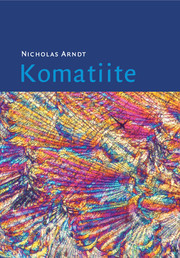Book contents
- Frontmatter
- Contents
- Preface
- Part I Background information – description of the field characteristics, mineralogy and geochemistry of komatiites
- 1 A brief history of komatiite studies and a discussion of komatiite nomenclature
- 2 Brief descriptions of six classic komatiite occurrences
- 3 Field characteristics, textures and structures
- 4 Mineralogy
- 5 Geochemistry
- 6 Isotopic compositions of komatiites
- 7 Experimental petrology
- Part II Interpretation – the manner of emplacement, the origin and the tectonic setting of komatiites
- References
- General index
- Localities
- Plate section
3 - Field characteristics, textures and structures
from Part I - Background information – description of the field characteristics, mineralogy and geochemistry of komatiites
Published online by Cambridge University Press: 27 August 2009
- Frontmatter
- Contents
- Preface
- Part I Background information – description of the field characteristics, mineralogy and geochemistry of komatiites
- 1 A brief history of komatiite studies and a discussion of komatiite nomenclature
- 2 Brief descriptions of six classic komatiite occurrences
- 3 Field characteristics, textures and structures
- 4 Mineralogy
- 5 Geochemistry
- 6 Isotopic compositions of komatiites
- 7 Experimental petrology
- Part II Interpretation – the manner of emplacement, the origin and the tectonic setting of komatiites
- References
- General index
- Localities
- Plate section
Summary
Introduction
Komatiites exhibit a remarkable range of textures and volcanic structures. The most spectacular ultramafic lava flows have differentiated into olivine spinifex-textured upper parts and olivine cumulate lower parts. Komatiitic basalts display similar textures with pyroxene rather than olivine as the dominant mineral. Pillows, columnar jointing and, in fragmental komatiites, a variety of textures and structures produced during explosive eruption and deposition are also encountered.
The textures and structures of komatiites have been described in many publications. More important early works, which dealt with komatiitic rocks in Southern Africa, Canada and Australia, include Naldrett and Mason (1968), Viljoen and Viljoen (1969a, b), Nesbitt (1971), Williams (1972), Pyke et al. (1973), Arndt et al. (1977), Nisbet et al. (1977) and Imreh (1978). The substance of these papers and the situation that existed after a decade of komatiite research were summarized by Donaldson (1982). Subsequent contributions include: excellent illustrations and descriptions of textures and structures in komatiites in the Crixas greenstone belt, Brazil, by Saboia and Teixeira (1980); detailed descriptions of the Alexo komatiite flow by Barnes (1983) and Arndt (1986a); new work on komatiites in the Quebec portion of the Abitibi belt by Mueller (2005); new descriptions of komatiite flows and lava lakes in the Yilgarn Block, Australia, by Thomson (1989), Hill et al. (1987), Barnes et al. (1988), Lesher (1989) and Dowling and Hill (1998); accounts of the field relations and textures of komatiites in the Barberton, Nondweni and Commondale greenstone belts (South Africa) by Byerly (1999), Lowe and Byerly (1999a) and Wilson et al. (1989, 2003); new and very detailed descriptions of komatiites in the type locality in the Barberton greenstone belt in South Africa by Dann (2000, 2001); and descriptions of the texturally unusual spinifex-textured komatiites on Gorgona Island, Colombia (by Aitken and Echeverria (1984) and Echeverria and Aitken (1986)).
- Type
- Chapter
- Information
- Komatiite , pp. 53 - 97Publisher: Cambridge University PressPrint publication year: 2008



